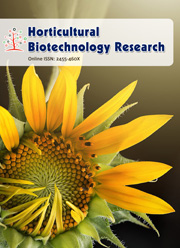Molecular markers in vegetable improvement
Abstract
Molecular markers directly reveal the polymorphism at the level of DNA. These are tags that can be used to identify specific genes and locate them in relation to other genes. Genetic mapping of disease resistance genes will help to improve the efficiency of plant breeding program, and it will lead to better understanding of the molecular basis of resistance. However, it requires reliable pathological tests and polymorphic genetic markers in a well-defined segregating population. Two strategies for developing markers for disease resistance genes are; the establishment of genetic maps with localization of major genes and quantitative trait locus; and targeting particular regions. Marker-assisted selection (MAS) is an effective tool for enhancing selection procedure in a breeding program. Therefore, MAS is using in the crop improvement program and also useful for the efficient
selection of many resistance genes for pyramiding into a single genotype.
Downloads
References
Ansari AM and Singh YV. Molecular Diversity of Brinjal (Solanum melongena L.) Genotypes Revealed by RAPD Marker. J Res (BAU) 2013;25(1):41-48.
Ansari AM and Singh YV. Molecular diversity of brinjal (Solanum melongena L. and S. aethiopicum L.) genotypes revealed by SSR markers. Electronic Journal of Plant Breeding 2014;5(4):722-728.
Archak S, Karihaloo JL and Jain A. RAPD markers reveal narrowing genetic base of Indian tomato cultivars. Curr Sci 2002;82:1139-1143.
Ashkenazi V, Chani E, Lavi U, Levy D, Hillel J and Veilleux RE. Development of microsatellite markers in potato and their use in phylogenetic and fingerprinting analyses. Genome 2001;44:50-62.
Botstein B, White RL, Stocknick M and Davis RW. Construction of genetic linkage map using restriction fragment length polymorphism. Ameri J Hum Genet 1980;32:314-331.
Broun P, Ganal MW and Tunksley SD. Telomeric arrays display high levels of heritable polymorphism among closely related plant varieties. Proceedings National Academy of Sciences, USA 1992;89:1354-1357.
Causse MA, Fulton TM and Cho YG. Saturated molecular map of the rice genome based on an interspecific backcross population. Genetics 1994;138:1251-1274.
Dudley JW. Molecular markers in plant improvement: manipulation of genes affecting quantitative traits. Crop Sci 1993;33:660-668 (Errata in Crop Sci 33,1450;Crop Sci 34:322).
East EM. Studies on size inheritance in Nicotiana. Genetics 1915;1:164-176.
Ferriot M, Pico B and Nuez F. Morphological and molecular diversity of a collection of cucurbita maxima landraces. J Amer Soc Hort Sci 2004;129(1):60-69.
Fischer D and Bachmann K. Onion microsatellites for germplasm analysis and their use in assessing intra and interspecific relatedness within the subgenus Rhizirideum. Theor Appl Genet 2000;101:153-164.
Gaikwad AB, Archak S, Selvendran S, Gautam D and Kurihaloo JL. Efficiency of three molecular marker techniques in finger printing capsicum accessions. XIth Eucarpia meeting on genetics and breeding of Capsicum and Eggplant. 9-13 April, Antalya-Turkey; 2001. p. 96-99.
Geldermann H. Investigations on inheritance of quantitative characters in animals by gene markers. I. Methods. Theor Appl Genet 1975;46:319-330.
Hamann A, Zink D and Nagi W. Microsatellite fingerprinting in the genus Phaseolus. Genome 1995;38:507-515.
Heras L, Vazquez FJ, Jimenez JMC and Vico FR. RAPD fingerprinting of pepper (Capsicum annuum L.) breeding lines. Capsi and Eggplant Newsletter 1996;15:37-40.
Huang CC, Cui YY, Weng CR, Zabel P and Lindhout P. Development of diagnostic PCR markers closely linked to the tomato powdery mildew resistance gene ol-1 on chromosome 6 of tomato. Theor Appl Genet 2000;100:918-924.
Kaemmer D, Weising K, Beyermann B, Borner T, Eggplen JT and Kuhl G. Oligonucleotide fingerprinting of tomato DNA. Plant Breed 1995;114:12-17.
Lande R and Thompson R. Efficiency of marker assisted selection in the improvement of quantitative traits. Genetics 1990;124:743-756.
Lander ES and Botstein D, Mapping mendelian factors underlying quantitative traits using RFLP linkage maps. Genetics 1989;121:185-199.
Lefebvre V. Marquage moléculaire et analyse de résistances polygéniques: interaction piment (Capsicum annuum L) — Phytophthora capsici Leon. PhD Thesis, université de Paris XI-Orsay, France; 1993. p. 182.
Lefort-Buson M, Rodolphe F and Charcosset A. De nouvelles perspectives pour I’analyse génétique des caractères quantitatifs. 1. À la recherche des locus importants. Biofutur 1990;91:30-37.
Levi A and Thomas CE. ISSR and AFLP markers differ among American watermelon cultivars with limited genetic diversity. J Amer Soc Hort Sci 2004;129(4):553-558.
Martin GB, Brommonschenkel SH and Chungwongse J. Map-based cloning of a protein-kinase gene conferring disease resistance in tomato. Science 1993;262:1432-1436.
Mather K and Jinks JL. Biometrical Genetics. Chapman and Hall, 2nd Edition, London, UK; 1971. p. 382.
McGregor CE, Lambert CA, Greyling MM, Louw JH and Warnich L. A comaprative assessment of DNA fingerprinting techniques (RAPD, ISSR, AFLP and SSR) in tetraploid potato (Solanum tuberosum L.) germplasm. Euphytica 2000;113:135-144.
Melchinger AE. Use of molecular markers in breeding for oligogenic disease resistance. Plant Breed 1990;104:1-19.
Messeguer R, Ganal M, de Vicente MC, Young ND, Bolkan H and Tanksley SD. High resolution RFLP map around the root knot nematode resistance gene (Mi) in tomato. Theor Appl Genet 1991;82:529-536.
Michelmore RW, Paran I and Kesseli RV. Identification of markers linked to disease-resistance genes by bulked segregant analysis: a rapid method to detect markers in specific genomic regions by using segregating populations. Proc Natl Acad Sci USA 1991;88:9828-9832.
Mongko lporn O, Dokhmaihom Y, Kanchana O, Udomkan C and Pakdeevaraporn. Genetic purity test of F1 hybrid capsicum using molecular analysis. J. Horti. Sci. Biotechno 2004;79(3):449-451.
Muminoric J, Merz A and Melchinger AE. Genetic structure and diversity among radish varieties as inferred from AFLP and ISSR analyses. J Amer Soc Hort Sci 2005;130(1):79-87.
Nienhuis J, Helentjaris T, Slocum M, Ruggero B and Schaefer A. Restriction fragment length polymorphism analysis of loci associated with insect resistance in tomato. Crop Sci 1987;27:797-803.
Noli E, Conti S, Maccaferri M and Sanguineti MC. Molecular characterization of tomato cultivars. Seed Sci Techno 1999;27:1-10.
Prince JP, Lackney K, Angeles C, Blauth JR and Kyle MM. A survey of DNA polymorphism within the genus Capsicum and the fingerprinting of pepper cultivars. Genome 1995;38:224-231.
Rodolphe F and Lefort M. A multi-marker model for detecting chromosomal segments displaying QTL activity. Genetics 1993;134:1277-1288.
Ruiz JJ and Martinez SA. Genetic variability and relationship of closely related Spanish traditional cultivars of tomato as detected by SRAP and SSR markers. J Amer Soc Hort Sci 2005;130(1):88-94.
Shim SL and Jorgensen RB. Genetic structure in cultivated and wild carrots (Daucus carola L.) revealed by AFLP analysis. Theor Appl Genet 2000;101:227-233.
Sobir OT, Murata M and Motoyoshi F. Molecular characterization of the SCAR markers tightly linked to the Tm-2 locus of genus Lycopersicon. Theor Appl Genet 2000;101:64-69.
Tanksley SD, Ganal MW and Prince JP. High density molecular linkage maps of the tomato and potato genomes. Genetics 1992;132:1141-1160.
Tanksley SD, Young ND, Paterson AH and Bonierbale MW. RFLP mapping in plant breeding: new tools for an old science. Bio-Technology 1989;7:257-264.
Villand J, Skroch PW, Lai T, Hanson P, Kuo CG and Nienhuis J. Genetic variation among tomato accessions from primary and secondary centres of diversity. Crop Science 1998;38:1339-1347.
Vos P, Hogers R, Bleeker M, Reijans M, Van de Lee T, Hornes M, Frijters A, et al. AFLP: a technique for DNA fingerprinting. Nucleic Acids Research 1995;23:4407-4414.
Williams JGK, Kubelik KJ, Livak KJ, Rafalski JA and Tingey SV. DNA polymorphisms amplified by arbitrary primers are useful genetic markers. Nucleic Acids Research 1990;18:6531-6535.
Williamson VM, Ho JY, Wu FF, Miller N and Kaloshian I. A PCR based marker tightly linked to the nematode resistance gene, Mi, in tomato. Theor Appl Genet 1994;87:757-763.
Young ND and Tanksley SD. RFLP analysis of the size of chromosomal segments retained around the Tm-2 locus of tomato during backcross breeding. Theor Appl Genet 1989;77:353-359.
Young ND, Danesh D, Menancio-Hautea D, and Kumar L. Mapping oligogenic resistance to powdery mildew in mungbean with RFLPs. Theor Appl Genet 1993;87:243-249.
Yule GV. On the theory of inheritance of quantitative compound characters on the basis of Mendel’s laws - a preliminary note. Rep 3rd Int Conf Genet 1906; p.140-142.



 .
.